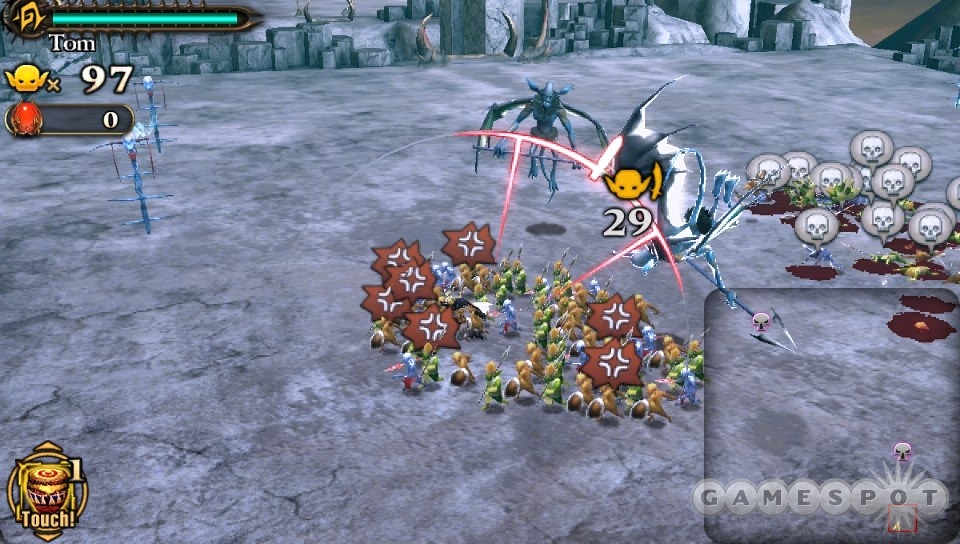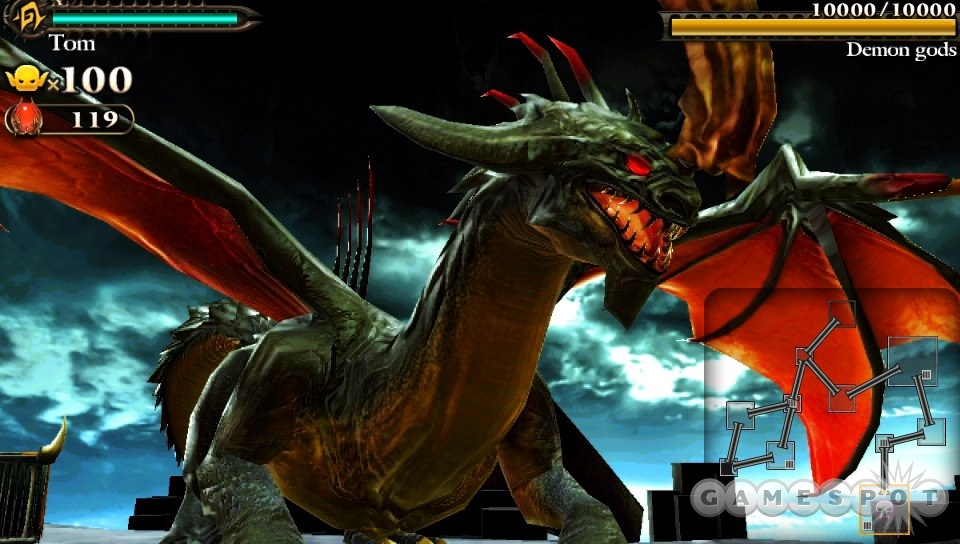Minions are a perk even a damned soul can relish. In Army Corps of Hell, you conquer the afterworld by controlling a horde of pint-size killers that happily do your evil bidding. Fountains of gore erupt from the dismembered demons that fall to your wrath, and this unrelenting bloodshed serves as the barbaric draw pushing you from one horrifying encounter to the next. But even unbridled bouts of brutality can grow tiresome after a while. As you stoically march from one arena to the next, viciously exterminating everything that stands before you, repetition drains the enjoyment as quickly as the pools of blood grow around you. There's undeniable satisfaction in the core action in Army Corps of Hell, but these ideas never blossom into something truly engaging.
You might think that the King of Hell would be an unopposed monarch in the realm of the perpetually punished. Not so in Army Corps. The Almighty defeated this noble demon, and you must right the wrongs done to you as you slowly rise to prominence once more. Between every stage are story sequences that map your progress. A harsh, guttural language born where fire and brimstone rule the landscape certainly sets a tone of morbidity, but the actual plot is slow to develop and tedious to follow. The lack of full animation in the many cutscenes is part of the reason, and the predictable dialogue does little to invest you in these infernal affairs.
As the King of Hell, you command an army of goblins eager to do your bidding. Levels are separated into confined arenas populated by angry beasts, and you unleash your army to kill them all, opening up a passage to the next area. Up to 100 goblins surround your character as you move across the battlefield, and they are broken up into three distinct classes that excel depending on the situation.
Soldiers are the most adept at close-quarters combat because they have both the raw strength and the defensive protection to slay most any beast that comes your way. Spearmen also thrive in melee duels, but they are used slightly differently. You send your entire troop across the arena at once. Watching dozens of these angry goblins sprint to slay a hovering eyeball is a majestic scene, though losing your protectors leaves you open to punishment from nearby beasts. Finally, the magi attack with long-range magical strikes, though they aren't nearly as powerful as the other two groups.

Combat involves switching between these three groups as you skillfully circle around the arenas. Elemental traps make walking blindly a deadly affair, so you have to move with precision if you want to avoid your opponents' strikes while landing retaliatory blows of your own. When your goblins are attacked they fall stunned to the ground, and you can revive them simply by walking over their prone bodies. If they stay on the ground too long, they eventually perish, and you need to purchase new goblins at special chambers to grow your army once more.
There is some strategy in advancing. Certain enemies are covered with flames or electrical currents, so you must use your magi while keeping your distance. Other enemies are vulnerable only from the back. A snake that erupts from the ground swallows your goblin army whole if you let him. Quickly dashing behind it and then sending your soldiers to pick away at its weak point is the quickest way to slay it. Other times, you may need to send your spearmen to fight an enemy from afar while you keep your soldiers nearby to fight another monster. Because a variety of enemies and traps litter each arena, you have to stay focused to survive. There's an undeniable thrill in conquering the tougher areas through skillful use of your goblin army. Furthermore, watching the bloody geyser that erupts from fallen foes is morbidly satisfying.
Aside from combat, there is a small crafting aspect that gives your goblins more power as you progress. Enemies can be harvested for their useful organs after battle, so once an arena is cleared of living souls, you collect their lifeless husks. Cleanup may be a bit gross, but after you complete a level, you get to combine these parts into useful tools. More powerful weapons and armor let you ornament your goblins in style, so it's well worth picking up all the odds and ends. Unfortunately, you don't get to keep these parts if you should die. Considering that levels can stretch on for 20 or more minutes, losing every last bit of your progress due to death is a serious setback.
There are some bigger flaws that take away some of the innate pleasure of hacking away at demons. Aiming where your troops are sent is the biggest problem. The right stick controls your view, not your aim, and because of this, you often get stuck sending your minions to places you didn't plan. Loot that litters the arena should be harvested after every enemy has fallen, not in the middle of a fight, but there are countless times when you send a soldier off for battle only to see it scavenging for goods instead. The Vita's touch capabilities are used sparingly, but poorly. Tapping the screen initiates a power-up, and then you drum the rear touch pad to get it to work. But this doesn't always work as it should, and considering you need these power-ups to revitalize your health bar, the unresponsive controls can spell your doom.
Most damning of all is the sheer repetition of your actions. Army Corps of Hell does not take place in a world ripe for exploration and conquest. Rather, each confined arena is a barren battlefield that only links to another small square on which to fight. Short bridges connect each of these plateaus, and you rush from one battle to the next, over and over again, with nothing to break up this interminable flow. Granted, the action is always fun, so Army Corps is ideal in short stretches. But a lack of enemy diversity means you enact the same basic strategies repeatedly, only against incrementally more challenging foes. The stale pacing gets tiresome after a few levels because you're rarely pushed to try new strategies or partake in different situations.
Thankfully, the boss fights are a bright spot in an otherwise static adventure. Many of the levels end with grueling battles against horrific monstrosities, and these are the only encounters that really challenge you. Two demon gods may confront you at once, slamming into the ground and breathing rays of deadly fire. Fast movement and precise attacks are needed to survive, but even if your strategy is sound, you may still fall in battle because these foes can squash your feeble army so quickly. The bosses are the highlight of Army Corps, but they show just how limiting the combat actually is. There are only a handful of ways to approach each fight, and the lack of flexibility makes it seem as if you're repeatedly going through the same motions in a slightly different setting.

Local cooperative play is a fine way to tear through levels with a buddy by your side. Each player has a group of goblins to control, and cutting down foes is even more fun when you can team up with a friend. Playing cooperatively doesn't dramatically change any of the core elements; it's just more fun to play through this demonic tale with someone else who relishes bloody battles. Score rankings also extend the life of the game if you crave even more hellish opportunities. You're graded on how quickly and skillfully you complete each level, and going back to earn high marks can be satisfying.
Army Corps of Hell is a good concept in an underdeveloped package. The action is so bloody and satisfying that chopping through demonic beasts is eminently fun. But that entertainment dries up as you get deeper into the game because there just isn't enough diversity to keep things feeling fresh. Even with that flaw looming over everything, Army Corps is still an entertaining trek through the netherworld.



